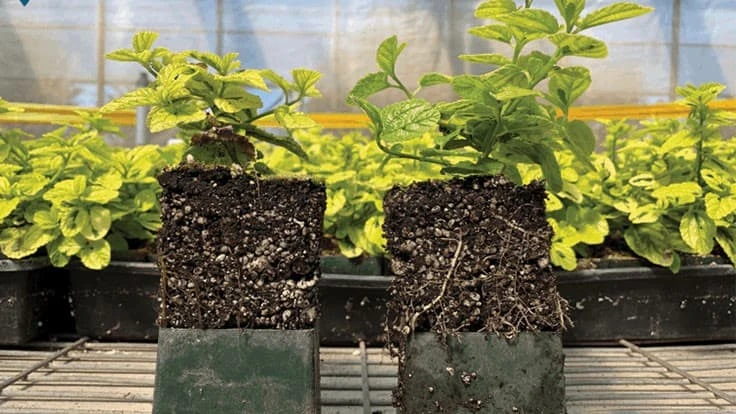

Mycorrhizal fungi are the superstars of your growing media ecosystem. These beneficial symbiotic soil organisms partner with your plants to create root-and-mycelial structures known as mycorrhizae, which play a large and complex role in boosting the development and adaptation of approximately 95% of plant species on the planet.
Growers can take advantage of mycorrhizae fungi to unlock efficiency gains within the plant root zone.
These fascinating, hard-working structures are created through the symbiotic colonization, and are able to solubilize and extract far more nutrients and water from the soil or growing media than plants’ roots alone. They’re able to actively transport and transfer macronutrients, micronutrients and water directly to the plant’s root system, improving overall plant performance.
The many varying genera and species of “mycos” have numerous plant benefits that go well beyond boosting fertility uptake and developing a stronger root system. Perhaps most importantly, these fungi naturally strengthen a plant’s internal defenses against environmental stressors and nutrient deficiencies, resulting in a more successful growing season in the greenhouse.
How do mycorrhizae work?
While there are many types of mycorrhizae naturally occurring in soils, the two types most essential for commercial greenhouse production are endomycorrhizae and ectomycorrhizae.
When these microscopic living organisms enter the root zone via inoculant application, the symbiotic relationship commences as mycorrhizae hyphae germinate and proliferate into both root tissues and the surrounding substrate, soil or growing media.
“It normally takes three to four weeks for the symbiosis to establish and for the fungi to provide the benefits for the plant, therefore it is important to introduce the mycorrhizal fungi as early as possible,” says Mycorrhizal Applications Technology Manager Jozsef Racsko.
During this process, the plant’s root zone is extended well beyond its typical footprint of soil colonization. This effectively increases the plant’s total root absorption area up to 50 times.
“The hyphae are much smaller in diameter than the smallest root (hair), therefore they can explore a greater volume of soilless media, providing a greater area for absorption,” Racsko says. “Additionally, the entire length of the hyphae mycelium can absorb water and nutrients, while in the case of the root hair absorption only occurs at the root tip.”
Also important to note, according to Racsko, is that root hairs are only capable of absorbing water-soluble nutrients, while the mycorrhizal hyphae can uptake both soluble and insoluble nutrients present in the soil, dramatically increasing the amount of nutrients available to young plants for vegetative growth.
Simply put, root systems inoculated with mycorrhizae show significantly greater potential for nutrient and water uptake than the plant’s own root system alone without the mycorrhizae.
Greenhouse growers produce plants in containers or pots, and containers only have so much soil volume they can explore and colonize before they become rootbound. “Mycorrhizae penetrate into the smallest pore spaces in the soil or growth media that otherwise would be unavailable to the roots,” Racsko says, adding that soil-bound nutrients require the microbial activity provided by mycorrhizae for uptake.

Evaluating mycorrhizal inoculant products
Like any fertilizer blend, mycorrhizal products contain both active and inert, or carrier, ingredients. The active ingredient is comprised of two main types of mycorrhizal propagules, spores and colonized root fragments. The spores are normally dormant and therefore germinate slower than the more rapidly germinating root fragments, which provide a faster colonization process of the root zone.
Commercially available mycorrhizal products come in one of three forms: granular formulation (excellent for soil incorporation), suspendable powders (increased application flexibility), and liquid formulations (easy to apply and new formulation can be combined with fertilizer).
The diversity of the fungal species present in the product is another important aspect to keep in mind.
“For instance, one species is very efficient in phosphorus uptake, the other one is very efficient in nitrogen uptake and the third one is very effective in reducing drought stress impacts on the plant,” Racsko says. “It’s very important to have a diversity of fungal species in mycorrhizal products.”
Speaking of diversity, mycos are beneficial to plants in virtual any commercial production system, from soilless growing mediums (artificial blends often lack naturally occurring microbes) to hydroponic systems and everything in between.
Application success leads to plant success
Mycorrhizal fungi are applied to plants via inoculation, or direct contact, with the root zone. This can be accomplished via various methods such as direct soil incorporation, plug or bare root dip, or drench via the overhead spray boom, as well as directly adding the propagules into the reservoir in hydroponic or controlled watering systems.
Early application is crucial to achieving the biggest benefit and one application is typically sufficient for the full plant life cycle of perennial and permanent crops. Annuals should be inoculated at planting, and it is important to remember that “overdosing” a plant on mycorrhizal fungi is not possible.
Ornamental growers need to keep in mind that certain pesticide applications can be harmful to mycorrhizal populations in the soil, so timing is critical. Racsko says that most horticultural insecticides and herbicides are generally safe to these beneficial fungi, but there are certain fungicidal modes of action (propiconazole, captan, etc.) that will greatly diminish effectiveness. Mycorrhizae are fungi too, and fungicides are used to kill fungi.
“If a fungicide has known negative effects on mycorrhizae, the mycorrhizae should be applied first and once the symbiosis forms then the fungicide can be applied, because it’s going to have less of a detrimental effect once the symbiosis has formed,” Racsko says.
Applying the science
Mycorrhizal Applications offers a wide range of inoculants for virtually any style of horticultural grow, says Mycorrhizal Applications Commercial Sales Manager Blair Busenbark.
The company offers granular and powder formulations for soil incorporation, plug dips and liner sprays formulated with suspendable powders and liquid media drenches as well as injectable blends that can run through irrigation drip tape or from the overhead boom sprayer.
Growers looking for a versatle product that can be incorporated into the soil or applied on plugs/liners or via media drench would be well-served in looking at the company’s MycoApply Ultrafine line of inoculants, which also comes in a combined endo/ecto blend.
To cut down on steps, a soil + MycoApply premix is often ideal. “One of the easiest things people can do is they can order a premix that already contains the mycorrhizae,” Busenbark says. “If you are interested in that please go to [mycorrhizae.com] and find out who your sales rep is for your region, and we can refer you to a soil manufacturer that can fill that request for premanufactured soil.”
Those who wish to inoculate via irrigation or in a hydroponic system have options as well with the MycoApply Injector Endo and Ecto lines. The Endo line even boasts an OMRI-listed endo formulation option that can be used on edibles and consumables, containing multiple species of arbuscular mycorrhizal fungi on a soluble humic carrier.

Explore the October 2020 Issue
Check out more from this issue and find your next story to read.
Latest from Greenhouse Management
- 2025 Proven Winners Horticulture Scholarship applications now open
- How to improve inventory and shipping management in the greenhouse
- Leading Women of Horticulture: Anna Ball, Ball Hort, and Terri McEnaney, Bailey Nurseries
- GM CEA HERB Part 2: A guide to increasing the sowing density of culinary herbs
- GM CEA HERB Part 1: Best practices for producing culinary herbs in controlled environments
- USDA fires experts on invasive pests, including Asian citrus psyllid, chilli thrips
- CEA Alliance celebrates bipartisan introduction of Supporting Innovation in Agriculture Act
- Dümmen Orange North America celebrating 25th anniversary in 2025






